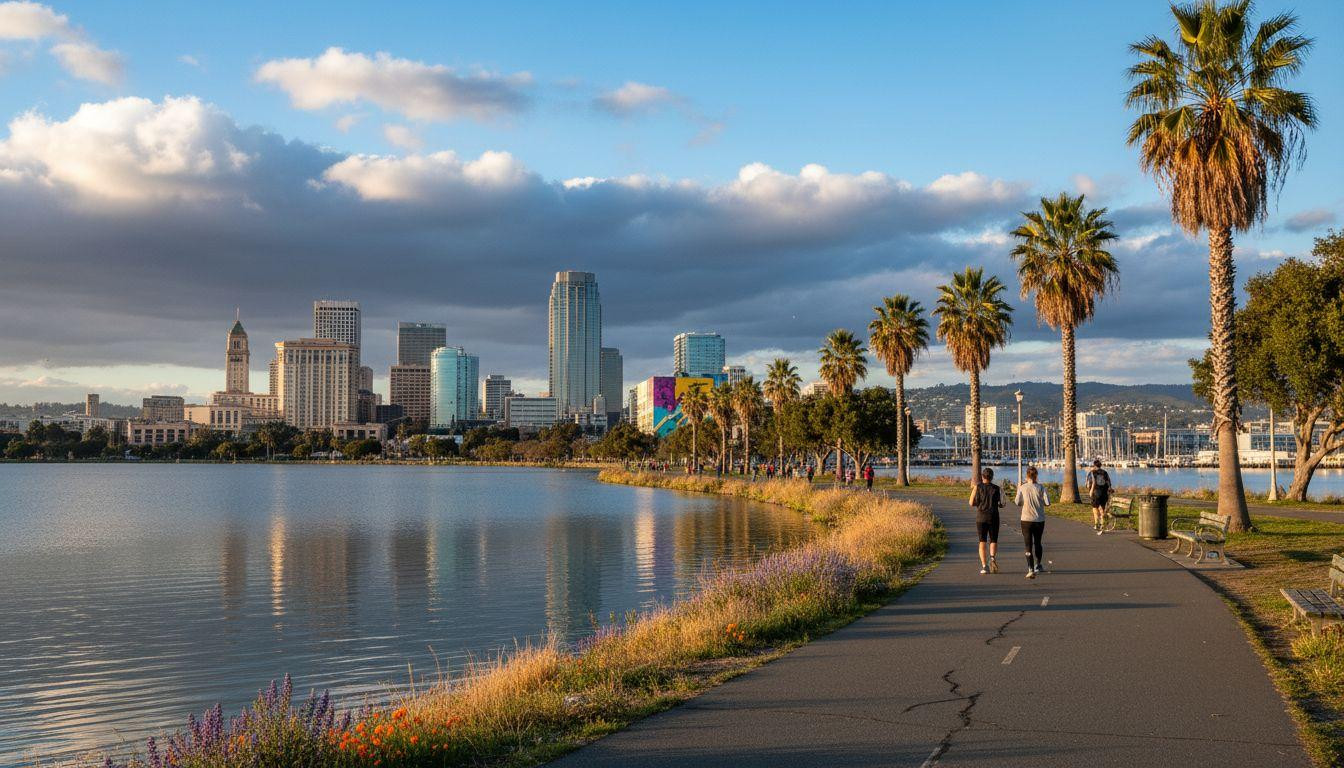The 20-minute BART ride from downtown San Francisco to 12th Street Oakland crosses more than just water. It bridges two worlds. On one side, tourists snap photos at $8 coffee shops with no seating. On the other, locals linger over Vietnamese pho while morning light filters through warehouse windows.
Oakland offers what San Francisco promised but can no longer deliver. Authentic Bay Area culture without the performance. Waterfront access without the crowds. Tech job proximity without the financial strain that forces families into hour-long commutes.
Where Bay Area locals actually choose to live
Lake Merritt at 7am reveals Oakland’s secret. Joggers circle the 3.4-mile path speaking three languages. Herons fish in shallow water. Coffee shops open their doors to neighborhood regulars, not Instagram tourists.
The numbers tell the story clearly. Oakland’s 2-bedroom average rent sits at $2,682 compared to San Francisco’s $3,318. Home prices average 51% lower than across the bay. But the real difference isn’t mathematical.
It’s finding parking on a Tuesday. It’s knowing your barista’s name. It’s attending community events where locals gather rather than pose for social media.
The food scene San Francisco gentrified away
Temescal District serves soul food and Vietnamese pho on the same block. No reservations required. No $20 appetizers. Just families running restaurants that feed neighborhoods, not food bloggers.
Soul food meets immigrant kitchens
Swan’s Market houses vendors serving Korean tacos and Nigerian jollof rice. Reem’s California bakes Arabic pastries steps from taco trucks. Oakland’s 440,000 residents represent 85 countries.
Food costs reflect this authenticity. Average meal prices range $20-$35 compared to San Francisco’s $25-$40. Quality stays high while pretension stays low.
Coffee culture without performance
Blue Bottle originated in Oakland’s Temescal neighborhood before venture capital transformed it. Local roasters like Red Bay Coffee and Highwire Coffee remain community-focused. Laptops welcome, but conversation thrives.
Coffee shops serve regulars, not influencers. Morning conversations happen in Spanish, Mandarin, and English. Cultural communities preserve traditions rather than package them for tourists.
Art that lives in streets, not galleries
Uptown Oakland displays more murals per square mile than any Bay Area neighborhood. Artists paint community stories, not commissioned marketing pieces. Political murals address local housing struggles. Cultural murals celebrate immigrant contributions.
Mural districts tell neighborhood stories
The Uptown corridor between 14th and 27th Streets showcases 40+ murals. Artists document gentrification, celebrate diversity, demand justice. These aren’t Instagram backdrops but community newspapers painted in bright colors.
Oakland Art Murmur happens first Fridays monthly. Galleries open late, food trucks gather, musicians perform. Art serves residents first, visitors second.
Oakland Museum of California expands in 2025
The museum’s contemporary art collection doubled this year. New exhibits focus on California stories told by Californians. Admission costs $16 compared to SFMOMA’s $35.
Interactive exhibits explore Bay Area innovation beyond Silicon Valley mythology. Sustainable urban development showcases Oakland’s environmental leadership.
Waterfront access locals actually use
Jack London Square offers bay views without Fisherman’s Wharf chaos. Restaurants serve locals lunch, not tourists overpriced crab. Weekend farmers markets feature produce grown within 50 miles.
Oakland Estuary provides kayak access, walking trails, and bird watching. No entry fees. No parking meters. Just water access in a region where public beaches cost $10 to park.
BART connects Oakland’s waterfront to San Francisco’s Financial District in 20 minutes. California coastal experiences become day trips rather than expensive weekend getaways.
Your questions about Oakland’s livability answered
How reliable is BART for daily commutes?
BART runs every 8-12 minutes during peak hours. 12th Street Oakland to Embarcadero takes exactly 18 minutes. Monthly passes cost $75-$120 depending on distance. Mobile ticketing eliminates paper tickets.
Tech companies operate shuttle services from Oakland BART stations. Google, Apple, and Meta buses serve downtown Oakland stops. Total commute time often equals driving from South Bay.
Which Oakland neighborhoods suit tech workers best?
Temescal offers walkable restaurants and quick BART access. Uptown provides downtown energy with reasonable rents. Jack London Square combines waterfront living with ferry service to San Francisco.
Home prices declined 5.8% year-over-year in 2025. Oakland housing costs approach normal market conditions while San Francisco remains unaffordable for median earners.
How does Oakland’s diversity feel in daily life?
Oakland’s 440,000 residents speak 85+ languages. City council meetings offer translation services. Public schools teach in Spanish, Mandarin, and Arabic. Cultural festivals celebrate communities year-round rather than tokenize them.
Neighborhood demographics reflect economic diversity. Teachers, firefighters, and nurses live where they work. Tech workers choose Oakland for community, not just cost savings.
Evening fog rolls across the bay toward San Francisco while Oakland’s hills catch golden light. Lake Merritt reflects clear sky as downtown towers illuminate. Two cities, one choice. Oakland chooses community over performance, authenticity over image, livability over spectacle.
